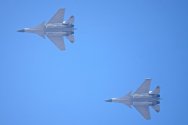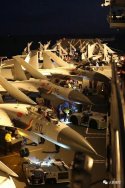From what I understand a STOBAR aircraft does not need any strengthening for doing flights from a ski jump. What it will need strengthening for is so the airframe can withstand the stresses of the arrested recovery with the tail hook.
A CATOBAR aircraft will also need strengthening of the airframe so it can withstand the stresses of catapult launch. This includes strengthening of the landing gear. But this is supposedly much less of a problem with EMALS than with a steam catapult.
No, the problem we face is we do not know whether a STOBAR aircraft requires any additional strengthening for taking off from a ski jump (independent of the strengthening to do arrested landings, which a CATOBAR aircraft has to do as well).
I'll break it down to bullet points in terms of airframe strengthening relevant to carrier landings and takeoffs:
- Both STOBAR and CATOBAR compatible aircraft will need the same kind of fuselage reinforcement for doing arrested landings
- CATOBAR compatible aircraft require nose gear launch bar and hold back faculties, as well as fuselage reinforcement for the forward "pull"/shear force of a catapult launch
- We do not know if STOBAR compatible aircraft require fuselage strengthening independent of the reinforcement for doing arrested landings, to account for the ski jump launch in a sustainable and long term fashion (e.g.: does the ski jump launch impose a vertical/upwards stress on the aircraft's landing gear and fuselage which is different in nature from the arrested landing)
The potential significance of the answer being yes or no is quite significant for how we view future airwing procurement, so we can't get away with "we suspect" or "our understanding is". We would really need definitive knowledge that likely right now only SAC and the PLANAF has, so unless there is watertight evidence, right now the best answer and only answer that we should come up with is "we don't know".



